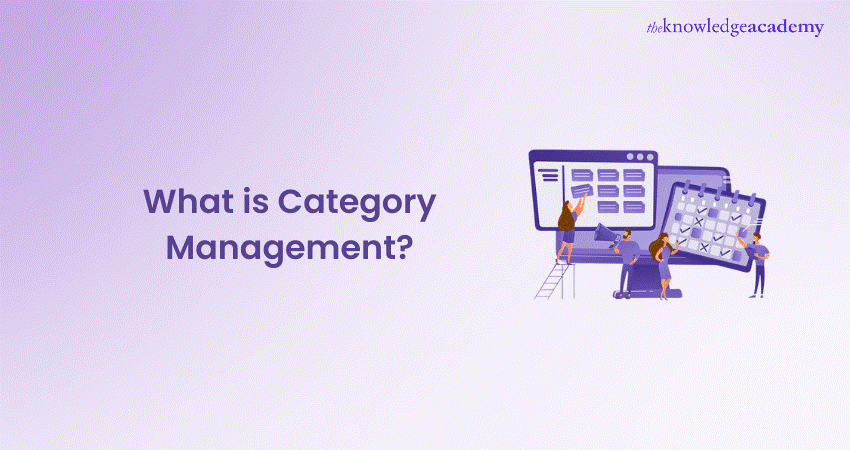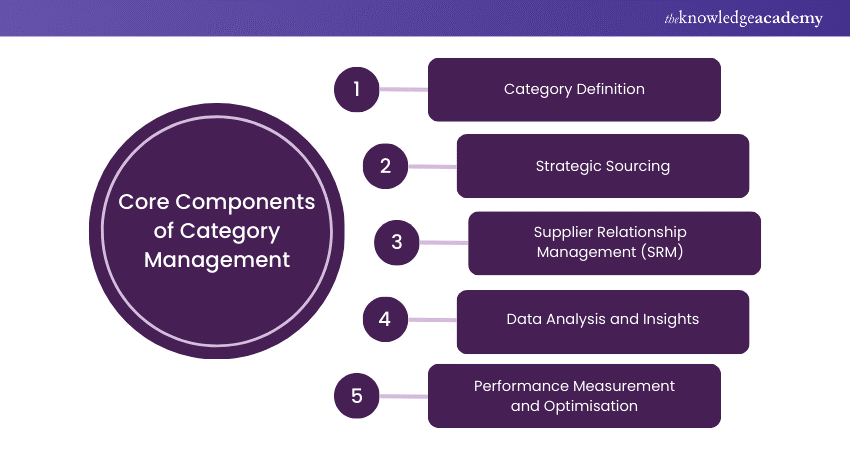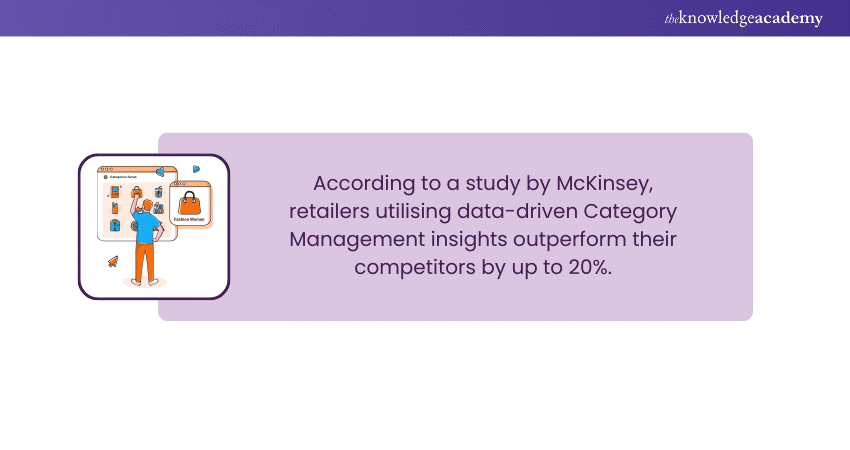We may not have the course you’re looking for. If you enquire or give us a call on +44 1344 203 999 and speak to our training experts, we may still be able to help with your training requirements.
Training Outcomes Within Your Budget!
We ensure quality, budget-alignment, and timely delivery by our expert instructors.

What if you had a smart toolbox for your business that helped you group similar products and treat each group as its own mini business? This clever approach is at the heart of Category Management. It's a technique in procurement where you can create teams of products, each with its own playbook for success, thus optimising purchases, streamlining supply chains and improving customer satisfaction.
If you are looking for deeper insight regarding the same, this blog will take you through every aspect of What is Category Management. Read on and learn why this method is vital for modern businesses to stay efficient and competitive.
Table of Contents
1) What is Category Management?
2) Importance of Category Management in Procurement
3) Core Components of Category Management
4) Four Ps of Category Management
5) Types of Category Management Strategies
6) Three Key Steps in the Category Management Process
7) Advantages of Category Management
8) Challenges of Category Management
9) Best Practices for Implementing a Successful Category Management Strategy
10) Conclusion
What is Category Management?
Category Management is a systematic approach to managing product categories as strategic business units, rather than individual products. It covers a range of activities to maximise every category's value while aligning with overarching organisational goals.
At its core, Category Management involves analysing consumer preferences, market trends, and competitive landscapes to make informed decisions about product pricing, assortment, and promotion strategies.
In recent years, Category Management has evolved beyond its traditional retail origins and is now widely adopted across industries such as healthcare, manufacturing, and hospitality. This evolution reflects its versatility in driving business performance in diverse contexts.
Importance of Category Management in Procurement
Category Management is critical because it goes beyond purchasing goods and guides the team's strategy for building and maintaining supplier relationships, allowing for deeper negotiations and program development. It applies structured and analytic processes to procurement by dividing procurement into specific categories, each encompassing a group of similar products or services.
Imagine a scenario where a costly purchase order has been made for your organisation, and moments later, it's discovered that the very same items are available at another supplier at a fraction of the price. Category Management in procurement prevents that.
Core Components of Category Management
The core components of Category Management include strategic sourcing, performance measurement and supplier relationship management, as detailed below:

1) Category Definition: A category is a group of products or services that serve a common purpose for consumers. Effective Category Management begins with clearly defining each category's boundaries and understanding its role within the overall product portfolio.
2) Strategic Sourcing: This involves proactively identifying, evaluating, and selecting suppliers to optimise costs, quality, and delivery performance.
3) Supplier Relationship Management (SRM): SRM focuses on building and maintaining collaborative partnerships with suppliers to achieve mutual benefits. It involves transparent communication and continuous performance evaluation to drive competitive advantage.
4) Data Analysis and Insights: Data analytics is critical in Category Management because it provides actionable insights into consumer behaviour, market trends, and product performance.
5) Performance Measurement and Optimisation: Measuring and optimising category performance is vital for driving continuous improvement and achieving business objectives. Key performance indicators (KPIs) such as profitability, sales, and customer satisfaction are used to identify areas for optimisation.
Gain a firm grasp of the tools and strategies for supply chain risk management excellence through our CIPS Level 5 Advanced Diploma in Procurement and Supply Course – Sign up now!
Four Ps of Category Management
The four Ps of Category Management are:
1) Planning
2) Procurement
3) Performance
4) Promotion
Each element is essential, but they must work together to develop a successful Category Management program. Let's explore each one more closely.
Planning
The first step of any Category Management strategy is a clear understanding of the category's strategic importance to the business. This includes identifying the organisation's goals by managing the category and the specific tactics used to achieve those goals.
Once the category's strategic importance has been established, the next step is to build a set of objectives for the Category Management program. These objectives must align with the program’s overarching goal and must be achievable within a defined time frame.
Procurement
The procurement process is responsible for contracting with suppliers who can offer the services and products the company needs. This category of management procurement involves working with suppliers to negotiate favourable contracts and ensuring that every sourced product or service meets the quality standards that the company has set.
Performance
Once contracts have been established, it is crucial to monitor suppliers' performance to ensure they meet the company's expectations. This includes tracking various supplier performance metrics such as quality levels, on-time delivery, and pricing. It also involves collaborating with suppliers to resolve any issues that may arise.
Promotion
As the final element of Category Management, promotion is responsible for executing marketing plans that are designed to increase awareness and demand for products or services within the category. This may include activities such as advertising and public relations.

Types of Category Management Strategies
There are four major types of Category Management - Exclusive, selective, non-selective and private label. We explore each of them below:
Exclusive Category Management
This strategy involves a retailer only carrying products from one supplier in a product category. This can develop customer loyalty and increase supplier and retailer market share.
Selective Category Management
Selective Category Management is when a retailer purchases products from multiple suppliers in any given category. This helps the retailer provide more choices to customers and negotiate better prices with suppliers.
Non-Selective Category Management
Non-selective Category Management involves a retailer carrying products from every supplier in a product category. This can provide customers with the broadest possible choices but can be more expensive for the retailer.
Private Label
In the case of private labelling, the retailer creates private-label products and sells them under its brand name. This strategy helps retailers create unique products that stand out from their competitors.
Some retailers opt for a custom approach, combining these Category Management strategies to meet their needs. The key is to be responsible for considering all options and selecting the plan that best aligns with the retailer's goals.
Want to learn about the fundamentals of Category Management? Sign up for our comprehensive Category Management Training now!
Three Key Steps in the Category Management Process
Though the process can vary from organisation to organisation, Category Management typically includes these three steps:
1) Define Category Profiles: Teams must start by analysing current spending and weighing various factors from risk and regulations to business logic. This helps them identify categories. The result is a consolidated category taxonomy for purchasing that can be utilised across the organisation.
2) Outline and Plan Strategy: In this step, teams evaluate their categories based on supplier performance, pricing, and supply and demand forecasts to identify opportunities for optimising spend and increasing value. Based on this information, they create a master strategy to achieve the goals of each category, broken down into specific phases and tactics.
3) Execute Strategy and Monitor Outcomes: The final step involves launching the strategy and continuously monitoring the outcomes, suppliers, business needs, and markets. This helps teams rapidly respond to change and optimise category strategies as needed.
Advantages of Category Management
The main advantages of employing Category Management strategies include the following:

1) Improved Performance of Vendors: An effective Category Management plan can help your business work more effectively with vendors and secure the time between the start and end of the process. Category Management can also help a new vendor or contract with layers of modifications.
2) Better Client Satisfaction: Category Management helps a Category Manager oversee every element of a given contract or service, including sourcing requirements, collecting bids, and negotiating contracts with diverse suppliers. This provides plenty of time for businesspeople to focus on their work and deliver value-based services to satisfy the client’s needs.
3) Improved Relationships With Diverse Suppliers: Management of category offers an opportunity to develop contacts within the organisation's structure, which is vital for both big and small businesses. So, creating and organising effective communication through Category Management aids in improving relationships between diverse vendors.
4) Better Insights Into Spending and Negotiating Product Price: Category Management can facilitate a better understanding of standard expenditures and the cost of existing and upcoming contracts.
Challenges of Category Management
Despite its many benefits, Category Management can pose significant challenges for businesses including the following:
1) Complexity of Data Management: Managing and analysing large volumes of data can be challenging within Category Management. Businesses may encounter difficulties in gathering, organising, and interpreting data from multiple sources.
2) Integration with Business Processes: Integrating Category Management into existing business processes can pose significant challenges, particularly in organisations with complex legacy systems.
3) Organisational Alignment: Achieving alignment across numerous departments and stakeholders is critical for the success of Category Management initiatives. Businesses may face resistance to change or siloed decision-making processes that inhibit collaboration and Category Management effectiveness.
Best Practices for Implementing a Successful Category Management Strategy
Developing a winning Category Management strategy can be effectively accomplished with the following best practices:
1) Establishing a Dedicated Category Manager and Team: Since large categories and areas of spend require time and specialisation, having a dedicated team of knowledgeable stakeholders from relevant departments makes for an effective process.
2) Creating Consistent Taxonomy Across the Organisation: This is crucial for gaining broader insights and visibility into spending. While some organisations use universal standards as a guide, companies will often create internal categories that better align with their unique goals or industry needs.
3) Using Automated Solutions to Centralise Data Spending: With a single place to track and monitor data, finding and reporting important insights and bolstering governance practices is easier.
4) Harnessing Category Management Technology: Using technology such as AI can help teams spot patterns more easily, automatically categorise spending, set benchmarks, organise suppliers by category, make recommendations, automate tasks, and more.
5) Keeping Stakeholders Engaged and in the Loop: Analytics software and tools for communicating wins and opportunities make it easier to get stakeholder buy-in and align with organisational goals.
6) Building Dynamic Supplier Relationships: This involves focusing on overall value rather than costs and openly collaborating to create good working relationships.
7) Incorporate Third-party Data: It's highly advisable to develop a mechanism to complement your category strategy through relevant external data points from third-party providers.
8) Continually Hone the Category Lifecycle Process: Improving internal and external data analysis by gathering category-specific intelligence, enhancing strategy, and conducting periodic reviews is essential.
Conclusion
To conclude, understanding What is Category Management will help you optimise product assortment, enhance customer satisfaction and drive profitability for your business. By analysing market trends and changing consumer needs, you can effectively manage categories of your products to improve performance. Effective Category Management builds stronger supplier relationships and positions companies to stay ahead in the competitive business landscape.
Want to gain deeper insight into the ethical aspects of complex procurement environments? Our CIPS Level 6 Professional Diploma in Procurement and Supply Course will guide you – Sign up now!
Frequently Asked Questions

Category Managers utilise spend analysis:
a) To identify inefficiencies and inform budget allocations.
b) To define categories and mechanics within each category.
c) To improve Category Management by understanding spending on different items.
d) To determine savings opportunities for each category.
d) To ensure continuous improvement.

The scope of a Category Manager includes managing a specific category of products within a company. They analyse consumer and industry trends, develop strategies, and oversee promotion, pricing, and product range management to maximise sales and profitability.

The Knowledge Academy takes global learning to new heights, offering over 30,000 online courses across 490+ locations in 220 countries. This expansive reach ensures accessibility and convenience for learners worldwide.
Alongside our diverse Online Course Catalogue, encompassing 19 major categories, we go the extra mile by providing a plethora of free educational Online Resources like News updates, Blogs, videos, webinars, and interview questions. Tailoring learning experiences further, professionals can maximise value with customisable Course Bundles of TKA.

The Knowledge Academy’s Knowledge Pass, a prepaid voucher, adds another layer of flexibility, allowing course bookings over a 12-month period. Join us on a journey where education knows no bounds.

The Knowledge Academy offers various CIPS Courses, including the CIPS Level 2 Certificate in Procurement and Supply Operations Course and the CIPS Level 5 Advanced Diploma in Procurement and Supply Course. These courses cater to different skill levels, providing comprehensive insights into Accounting Principles.
Our Accounting and Finance Blogs cover a range of topics related to accounting and procurement, offering valuable resources, best practices, and industry insights. Whether you are a beginner or looking to advance your procurement and Supply Chain Management skills, The Knowledge Academy's diverse courses and informative blogs have got you covered.
Upcoming Accounting and Finance Resources Batches & Dates
Date
 Category Management Training
Category Management Training
Fri 17th Jan 2025
Fri 21st Feb 2025
Fri 4th Apr 2025
Fri 6th Jun 2025
Fri 25th Jul 2025
Fri 7th Nov 2025
Fri 26th Dec 2025







 Top Rated Course
Top Rated Course



 If you wish to make any changes to your course, please
If you wish to make any changes to your course, please


